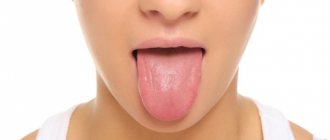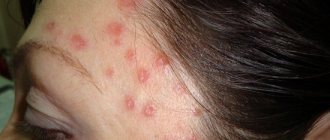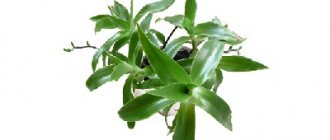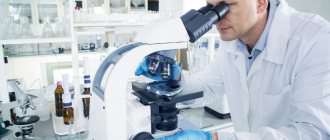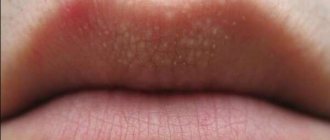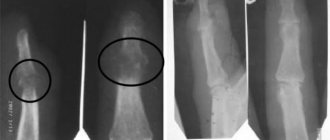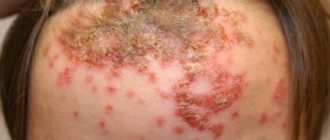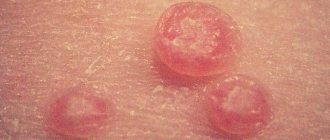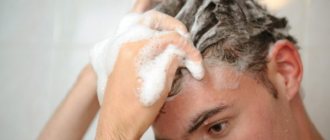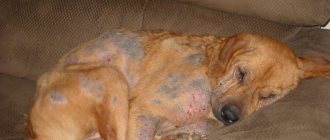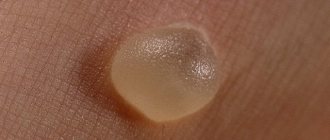Do you suspect you have lichen? Don’t know what its symptoms, types, treatment methods are? Would you like to know the causes of this disease, possible complications, as well as existing preventive measures? We will tell you all the most interesting things about this insidious disease!
Clinical symptoms of lichen depend entirely on the type of virus or fungus
General signs of the disease and symptoms
Clinical symptoms of lichen completely depend on the type of virus or fungus that caused it, and therefore can manifest as:
- increased body temperature;
- malaise and general weakness associated with intoxication of the body;
- enlarged lymph nodes;
- skin rashes with the presence of papules or spots with uneven outlines;
- peeling, itching and even pain in the affected areas.
If you find yourself with several of the symptoms listed above, immediately consult a dermatologist for an accurate diagnosis and timely drug treatment to quickly get rid of this disease without serious consequences and complications!
Treatment
People who have contracted this disease are often confused and do not know how to treat lichen on the face. Only a full cycle of treatment will help get rid of this problem. There are a number of drugs that will help you quickly get rid of such an insidious disease as lichen on a person’s face. Standard treatment for the disease is to take:
- Immunomodulators.
- Vitamin therapy is a combination of Retinol and nicotinic acid, or vitamin B1 with a solution of thiamine bromide.
- Taking antifungal drugs: Griseofulvin, Valaciclovir.
- The use of local drugs: clotrimazole, Mycoseptin, exoderil, ketoconazole.
- If there is severe lichen on the face, then you can use solutions that soothe the itching: alcohol with citric acid and metol. For small rashes, hormonal ointments are recommended: flucinar, sinaflan, ointment containing prednisolone.
Causes
The most common causes of lichen on the face are:
- direct contact with viruses/fungi found on animal fur;
- household contact with a person who is a carrier of lichen;
- reduced immune defense of the body;
- tendency to allergic diseases;
- prolonged stress conditions and diseases of the nervous system;
- vitamin deficiencies;
- hereditary factors;
- frequent colds;
- bites of certain insect carriers;
- improper or insufficient skin care;
- non-compliance with hygiene measures - mandatory hand washing after contact with animals and visiting public places;
- damage by helminthic infestations;
- problems with the gastrointestinal tract;
- oncological diseases.
General concepts about the disease
Ringworm on the face is a generalized concept of a group of infectious diseases called dermatoses.
The pathogen parasitizes on the surface of the skin, where it disrupts the epidermis, its pigmentation and hair. In addition, while in the body, the disease causes general malaise. The causative agent of the disease is fungi and viruses. And they most often affect a weakened body, when, against the background of reduced immunity, there is no strength to fight them. Ringworm can affect the body, legs, and is a frequent guest on the face and hands.
Having different origins, the disease is difficult to diagnose; you can only get rid of it with medication. It takes a long time to treat lichen; treatment is selected carefully, since different types of lichen require different medications.
The disease affects different age groups and, initially manifesting itself as a rash, is mistaken for allergic manifestations or herpes on the face. Therefore, people do not immediately consult a doctor, giving the infection time to multiply.
The disease must be treated as early as possible to prevent complications, and it looks scary. The fungal etiology of this disease is based on the use of antifungal treatment.
Existing types of lichen
- Pityriasis rosea is considered the most common type of infectious lesion of the skin of the face, very difficult to diagnose, since its manifestations are similar to allergic reactions, accompanied by itching, peeling, burning, pale pink lesions with unclear and blurred boundaries. Additional symptoms are a slight increase in body temperature and general weakness. The duration of the disease, subject to treatment, is from 1 to 2 months.
- Lichen planus , as a rule, affects the mucous membranes of the lips and mouth, but can also appear on the surface of the face in the form of tubercles of a pale pink or purple hue, turning into ulcers under the influence of various irritation factors. The shape of such spots is ring-shaped, erythematous, and resembles warts.
- Ringworm affects the areas of the face bordering the hair, as well as the chin. It looks like pink spots with uneven outlines and a white edge. In the center of such formations, yellow or gray crusts appear over time. This type of lichen is characterized by mild itching and lesions of varying sizes (from 1 to 3 centimeters). The first symptoms may appear as early as 5-10 days after contact with the carrier.
- Microsporia is a type of ringworm that affects the epidermis in the area of the forehead, temples, and neck, which are in contact with the scalp. The spots that form on the skin are characterized by a pale pink tint with a darker edging around the edges and peeling in the center. Their shape can be varied. This type of lichen is rarely accompanied by itching.
- The pityriasis versicolor type is characterized by pinkish-brown spots with uneven and not clearly defined boundaries, itching and flaking after scratching.
- Weeping lichen is characterized by multiple small blisters that, after opening, form erosions containing oozing serous fluid. As they dry, they turn into crusts, causing severe itching and burning, preventing normal rest at night.
- The first signs of shingles on the face are pain on the skin, aggravated by touch, a significant increase in body temperature, and a general deterioration in well-being. External manifestations have the form of edematous spots of light red color, covered with blisters with liquid contents. After the blisters burst, dense crusts form on the skin.
Treatment of the problem
Medications
It is necessary to treat lichen of any type in a comprehensive manner; do not forget that the initial stage of lichen can be cured in the shortest possible time without the use of heavy medications. More often a course of immunomodulators, such as Reaferon or Dekaris, is prescribed. Local products that should be applied to the lichen areas will help remove inflammation and avoid bacterial infection. This includes Mycoseptin and Exoderil, which has a similar effect. It is recommended to drink Griseofulvin, Acyclovir, and Valacyclovir orally.
It will be possible to cure an advanced form of ringworm in a hospital setting; at home it will be difficult to provide suitable conditions and completely isolate the patient. For pityriasis rosea, no special therapy is required. If you are concerned about discomfort and other unpleasant symptoms, the doctor will prescribe painkillers, such as Tavegil or Zyrtec.
Folk remedies
In advanced forms of the disease, folk remedies are not effective.
Before you begin treating rash lesions with folk remedies, you should consult with a dermatologist about the effectiveness of such treatment, because often with advanced forms of some types of the disease, folk treatment can only aggravate the situation and worsen the patient’s condition.
Basic approaches:
- If lichen rashes appear on your face, you can wash your face daily with an infusion of chamomile and string. Before each wash, prepare a new infusion of medium strength. You should not rub the skin with a towel; it is better to blot the affected areas with paper napkins.
- You can use apple cider vinegar as a lotion, which you blot on the affected areas at least 3 times a day. After 4-5 days, the itching and burning disappear, the skin becomes less irritated.
What treatment methods are there?
It is necessary to begin complex treatment of lichen only after diagnosing its type by a dermatologist. General therapeutic treatment methods include the use of the following drugs and equipment:
- antifungals for internal use (for example, acyclovir, valacyclovir, griseofulvin);
- antifungal ointments for external, local use (exoderil, clotrimazole, mycoseptin, micoconazole);
- immunomodulators to increase the body's defenses;
- vitamin ointments, iodine solution, sulfur-salicylic composition;
- cryotherapy using liquid nitrogen, ultraviolet irradiation, diathermocoagulation;
- anti-itch formulations (with menthol, anesthesin, sulfur, tar);
- ointments with corticosteroid hormones (prednisolone, sinaflan, flucinar, fluorocort).
Drug treatment
Each type of lichen has its own treatment methods.
Ringworm
It usually affects the hairline, so before starting treatment, you need to cut off the hair on the affected area. Suitable medications include:
- any creams, shampoos and ointments containing Clotrimazole, Mycoseptin or Terbinafine. They will help relieve itching and burning;
- iodine, which dries and disinfects;
- salicylic acid or tar-sulfur ointment;
- Vidal's milk, which can be purchased at the pharmacy. This product has an antifungal effect;
- griseofulvin, which is taken orally;
- vitamins, minerals that will strengthen the immune system.
Pityriasis rosea
It usually goes away without treatment, but with severe itching you cannot do without:
- antihistamines;
- ointments Zomulan, Chlorophyllipt;
- milk thistle, sea buckthorn, apricot oils.
Attention! Do not use iodine or other drying agents. You also need to follow a diet, avoid heavy sweating and not wear synthetic clothing.
Lichen planus
The following drugs are used to treat this disease:
- hydrocortisone ointment;
- antibiotics, as well as medications to improve digestion (Linex);
- antihistamines that relieve itching - Cetrin, Zyrtec;
- for pain relief - Paracetamol, Ketonal, Ibuprofen.
Shingles
In this case, a visit to the doctor is necessary, since this disease quickly spreads throughout the body. For washing, it is better to use a decoction of string or chamomile. Suitable medications include:
- gel with Lidocaine, Ibuprofen, which relieves pain;
- antiherpetic drugs, which are usually prescribed to patients over 50 years of age with severe signs of infection;
- Epigen antiviral cream;
- brilliant green for treating affected areas.
In severe cases, plasmaphoresis, physiotherapy, and acupuncture may be prescribed.
Pityriasis versicolor
This infection reproduces well in hot climates, so high temperatures should be avoided. The following are used as therapy:
- UV rays;
- treatment of affected areas with Miconazole, Bifosin;
- antifungal cream - in the morning, and salicylic acid - at night, and agents - Clotrimazole, Nizoral and their analogues.
Possible complications
In the absence of proper treatment prescribed by a dermatologist, consequences may occur in the form of:
- gangrenous condition;
- spread of purulent infection in the body;
- lesions of the central nervous system;
- bacterial infection of the epidermis, leading to scar formation;
- hemorrhagic complications;
- damage to the mucous membrane of the eyes up to blindness;
- transition of the disease to a chronic form with constant relapses;
- the appearance of psoriatic erythoderma, generalized pustular psoriasis, psoriatic arthritis, facial paralysis.
Lichen
Belongs to the category of dermatitis, occurring in the form of a red rash and scaly melasma. These skin diseases are related to infectious pathologies and occur in any area of the body. They can affect not only the torso, but also the face. Favorite nesting sites are the chin, neck, and may appear on the cheeks. Usually, lichen occurs as a result of skin infection by external or pathogenic fungi, infections, and, based on the type of onset of the disease, a treatment regimen will be prescribed. Basically, it will be caused by taking antimycotic drugs. But their use alone does not guarantee complete success, so preference is given to complex treatment.
Prevention measures
In view of the severity of the disease, the long and difficult treatment period, and the possibility of a number of serious complications, it is best to take the following preventive measures to avoid this dangerous infection:
- increasing the body's immune defense;
- avoiding contact with stray animals, as well as mandatory hand washing after playing with pets;
- monitor the functioning of the gastrointestinal tract;
- try to eat as many foods high in vitamins as possible;
- be checked for parasites;
- undergo an examination of the body for oncological formations;
- fight long-term and protracted stress;
- monitor the health of the nervous system;
- try to have less contact with aggressive allergens;
- strengthen the body to avoid colds;
- Be sure to treat insect bites with antiseptic compounds.
What is lichen
Ringworm is a disease transmitted by contact from an infected person or animal. There are many varieties of it, but they all manifest themselves in the same way: itching, peeling and rashes on the skin. The causative agents of infection are viruses and fungi. However, people with a hereditary predisposition or those taking a number of medications for allergies can also get sick. Most often, lichen appears in people aged 30 to 70 years, and in children it is diagnosed much less frequently.
Ringworm in a dog
People at risk include:
- Subject to frequent stress.
- Exposure to hypothermia or overheating.
- With disturbances in the functioning of internal organs.
- Leading an unhealthy lifestyle and having bad habits.
Causes of deprivation on the face
There are many factors that contribute to the occurrence of lichen infection. Doctors include the most well-known reasons:
- weakened immune system;
- CNS diseases;
- deficiency of microelements, vitamins and other useful substances in the body;
- hypothermia;
- infection of a healthy person occurs through contact with cats and dogs – carriers of the fungus;
- long-term, frequent stressful situations;
- frequent colds;
- predisposition to allergies;
- the appearance of the disease may depend on problems with the digestive system;
- hereditary factor;
- insect bites;
- helminthiasis (the presence of worms in the human body).
Diagnosis of pathology
If you doubt whether there may be lichen on the face, and you think that the inflammation on the skin is caused by other reasons, you should consult a doctor. A dermatologist will examine problem areas and listen to your complaints. The doctor will then order tests for you.
- Scraping the skin from the affected areas.
- Sowing material on nutrient media. The method is indispensable if you need to determine the pathogen for a ringworm type of disease on the face.
- Balser's iodine test. This type of research is used to diagnose pityriasis versicolor.
- Blood analysis.
Having determined what type of lichen has attacked your skin, the dermatologist will decide how to treat the pathology.
A blood test may be needed to diagnose the disease.
Prevention
To avoid contracting an unpleasant disease, dermatologists suggest following simple rules of prevention:
- It is necessary to increase and strengthen the immune system.
- Contact with unfamiliar animals (cats, dogs, etc.) should be minimized.
- Treat pathologies of the central nervous system in a timely manner.
- Prolonged stressful situations should be avoided.
- Maintaining good body hygiene increases the chances of not becoming infected with pink, pityriasis versicolor or other types of lichen.
- Take vitamin supplements regularly and prevent colds.
- Anything that could cause an allergic reaction to the skin should be avoided.
- It is necessary to promptly treat helminthiases (helminthic infestations) and diseases of the digestive system. These problems often contribute to the development of shingles infection.
Elimination of lichen formation
To eliminate the herpetic type of the disease, complex therapy is prescribed:
- antiviral tablets (Acyclovir, Valavir);
- sedatives (Persen);
- products for external use (“Fukortsin”);
- painkillers.
In severe forms of the disease, the patient needs IVs.
Pityriasis rosea does not require complex treatment. If the affected areas are very itchy, the doctor will prescribe you antihistamine tablets (Tavegil, Suprastin).
To eliminate ringworm on the face, you will be prescribed the following treatment:
- antifungal tablets (Griseovulfine, Terbinafine);
- ointments with an antifungal effect, they can be smeared on the cheeks, forehead, chin, but antifungal emulsions should be used with caution by people who have inflamed circles near the eyes;
- zinc-salicylic paste is often used for ear rashes;
- iodine.
To get rid of pityriasis versicolor, the patient needs to use antifungal ointments (Lamisil, Ketoconazole) for a long time. With a progressive form of the disease, patients are prescribed tablets with an antifungal effect.
Lichen planus will leave you alone if you take antihistamines. You will need pills to strengthen your immune system.
Treating eczema is not easy. To eliminate this disease, patients are prescribed ointments with corticosteroid hormones (“Hydrocortisone”). It is mandatory to take antihistamine tablets. To strengthen the body, the patient takes B vitamins.
To eliminate psoriasis on the face, a dermatologist prescribes hormonal ointments (Mometasone) to people. If there are rashes on the nose and cheeks, you can safely use ointments based on tar and grease.
"Valavir" will help with herpetic lichen
Consequences
If the lichen on the face has gone away and the treatment has helped, this does not mean that no complications will arise. As a result of certain errors, the following consequences may occur:
- The inflammation process can spread to the eyes and cause conjunctivitis and other problems.
- If treated incorrectly, a chronic stage of the disease may develop.
- Bacterial diseases lead to scarring.
- Consequences may manifest themselves in the nervous system.
This is not a complete list of problems that may arise, so you should not start treatment and take it seriously.
